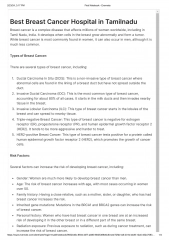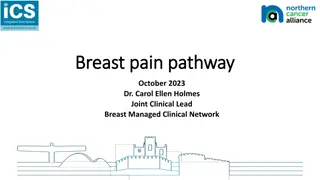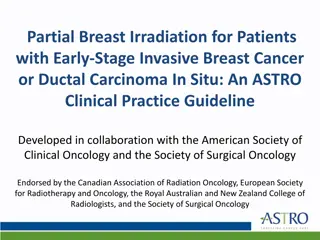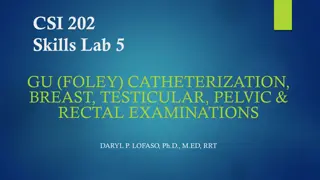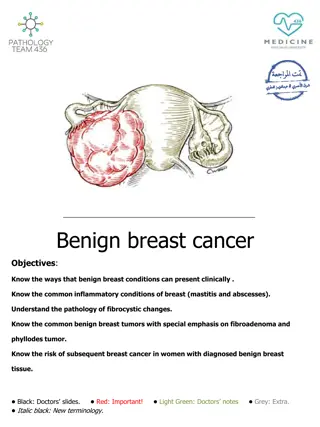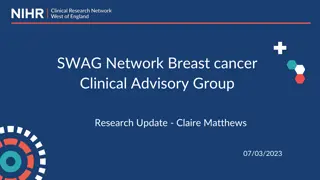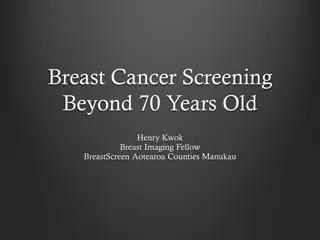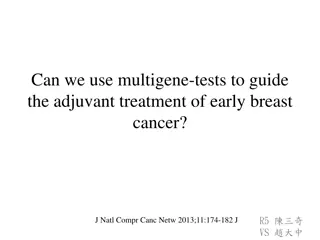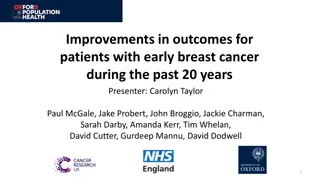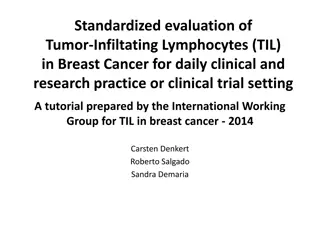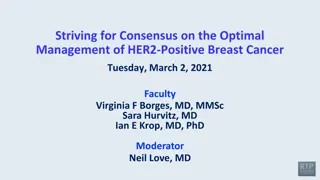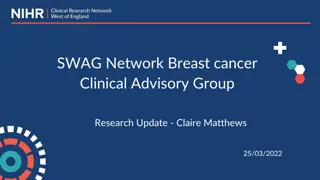POSNOC & ATNEC Trials Update by Amit Goyal: Investigating Axillary Treatment in Breast Cancer
POSNOC (Positive Sentinel Node) and ATNEC trials are investigating the effectiveness of axillary treatment in women with early-stage breast cancer having metastases in one or two sentinel nodes. Led by Chief Investigator Amit Goyal in the UK, this randomized controlled trial compares adjuvant therapy alone versus adjuvant therapy with axillary clearance or axillary radiotherapy. Patients with T1-2 invasive breast cancer undergo lumpectomy or mastectomy with sentinel node biopsy. Inclusion criteria include age over 18, unifocal or multifocal invasive tumor, and fit for axillary treatment and adjuvant therapy. Exclusion criteria cover various conditions like neoadjuvant therapy, previous axillary surgery, and recent malignancies. The trial aims to assess axillary recurrence, arm morbidity, quality of life, and survival over a 5-year follow-up period.
Download Presentation

Please find below an Image/Link to download the presentation.
The content on the website is provided AS IS for your information and personal use only. It may not be sold, licensed, or shared on other websites without obtaining consent from the author. Download presentation by click this link. If you encounter any issues during the download, it is possible that the publisher has removed the file from their server.
E N D
Presentation Transcript
POSNOC & ATNEC trials - update Amit Goyal (Chief Investigator) Consultant Oncoplastic Breast Surgeon & Associate Professor Royal Derby Hospital, Derby, United Kingdom
POSNOC POsitive Sentinel NOde: adjuvant therapy alone versus adjuvant therapy plus Clearance or axillary radiotherapy A randomised controlled trial of axillary treatment in women with early stage breast cancer who have metastases in one or two sentinel nodes www.posnoc.co.uk @POSNOC
POSNOC Largest UK breast cancer surgical trial 1st UK led international breast cancer surgical trial 3
Trial design Patients with T1-2 invasive breast cancer undergoing lumpectomy or mastectomy and sentinel node biopsy 1 or 2 Sentinel Node Macrometastases Randomise (n=1900) Systemic therapy plus axillary treatment (axillary node clearance or axillary RT) Systemic therapy alone Breast or Chest wall RT, Systemic Therapy, Follow-up 5 years Axillary recurrence, Arm morbidity, QoL, Survival
Inclusion Criteria Women will be eligible for inclusion only if ALL of the following criteria apply: 18 years or older T1 or T2 Unifocal or multi-focal invasive tumour 1 or 2 nodes with macrometastases Fit for axillary treatment and adjuvant therapy
Exclusion Criteria Women will be excluded if they have: Bilateral invasive breast cancer more than 2 nodes with macrometastases neoadjuvant therapy for breast cancer except o if sentinel node biopsy performed prior to neoadjuvant therapy in women with early breast cancer o short duration of neoadjuvant endocrine therapy is acceptable (up to 3 months) Previous ipsilateral axillary surgery not receiving adjuvant systemic therapy previous cancer less than 5 years previously or concomitant malignancy except o basal or squamous cell carcinoma of the skin o in situ carcinoma of the cervix o in situ melanoma o contra - or ipsilateral in situ breast cancer
POSNOC vs. Z11 Z11 POSNOC Size of metastases micrometastasis or macrometastasis macrometastasis Macrometastases 430 1700* Extranodal invasion x Mastectomy x Radiotherapy quality assurance x Mandatory pre-op axillary ultrasound x Sentinel node biopsy before NACT x *POSNOC recruitment ongoing (sample size 1900)
TOP 10 1 2 3 4 5 6 7 8 9 Royal Derby Hospital Wythenshawe Hospital Southmead Hospital Castle Hill Hospital John Radcliffe Hospital Belfast City Hospital Aberdeen Royal Infirmary Royal Melbourne Hospital Royal Marsden Hospital 93 39 38 36 35 34 34 34 33 10 The Royal Sussex County Hospital 31
ATNEC Axillary management in T1-3N1M0 breast cancer patients with needle biopsy proven nodal metastases at presentation after neoadjuvant chemotherapy @ATNEC1
Largest UK neoadjuvant breast cancer surgical trial 1st UK led international neoadjuvant breast cancer surgical trial
Research Question T1-3N1M0 who convert to no residual cancer in the lymph glands (ypN0) after NACT - omitting axillary treatment (removing all lymph glands in the armpit or radiotherapy to the armpit), is non-inferior (no worse) than axillary treatment
T1-3,N1,M0 early stage breast cancer with needle biopsy (fine needle aspiration or core biopsy) documented axillary node metastasis ATNEC trial Axillary management in T1-3N1M0 breast cancer patients with needle biopsy proven nodal metastases at presentation after neoadjuvant chemotherapy Mark the axillary node proven to have cancer cells on needle biopsy (using clip or carbon dye or seed as per local practice) NEOADJUVANT CHEMOTHERAPY (NACT) Axillary ultrasound Breast wide local excision or mastectomy + dual tracer sentinel node biopsy (at least 3 nodes removed sentinel nodes + marked node) Nodal metastasis (ITCs, micro or macrometastases) No nodal metastasis Eligible, consent and register Standard axillary treatment and follow-up RANDOMISATION 1:1 ALND, axillary lymph node dissection ART, axillary radiotherapy Sample size 1900, Follow up 5 years Co-primary outcomes Disease free survival, Lymphoedema Axillary treatment (n=950) ALND or ART (as per local practice) No Axillary treatment (n=950)
Study Design Pragmatic randomised, multi-centre, international trial Number of sites 100 (Target: 5 randomised per year/site) Sample size = 1900 Timeline o Trial start date 01 March 2020
Inclusion Criteria Age 18 Male or female T1-3N1M0 breast cancer at diagnosis (prior to NACT) by AJCC staging 7th edition FNA or core biopsy confirmed axillary nodal metastases at presentation Oestrogen receptor, progesterone receptor and HER2 status evaluated on primary tumour Received standard NACT as per local guidelines Ultrasound of the axilla at completion of NACT Undergo dual tracer sentinel node biopsy after NACT and at least 3 nodes removed (sentinel nodes and marked node) No nodal metastases post NACT (isolated tumour cells, micro or macrometastasis)
Exclusion Criteria Bilateral invasive breast cancer Sentinel node biopsy prior to NACT Previous axillary surgery on the same body side as the scheduled targeted sampling Previous cancer within 5 years or concomitant malignancy Stratification Institution Type of breast surgery (wide local excision or mastectomy) receptor status (triple negative, HER2+, ER/PR+ and HER2-)
Outcomes Primary o Disease free survival o Lymphoedema (co-primary outcome) Defined as YES to arm swelling now and arm heaviness in past year (LBCQ questionnaire) Secondary o Arm morbidity and quality of life (QuickDASH, EQ5D5L) o local (breast or chest wall) and regional (nodal) recurrence o distant metastasis, axillary recurrence free interval, overall survival o contralateral breast cancer o non-breast malignancy o economic evaluation
Marking of node Sites can adapt the pathways to their local preference. *Subject to CE marking. The node may be marked at the time of needle biopsy or at a separate visit.
Radiotherapy QA National Radiotherapy Trials Quality Assurance (RTTQA) Group Mount Vernon Cancer Centre | HA6 2RN
#makelymphoedemahistory Contact: amit.goyal@nhs.net Please sign up !!! Yeovil District Hospital NHS Foundation Trust Poole Hospital NHS Foundation Trust Cheltenham General Hospital Royal United Hospitals Bath


